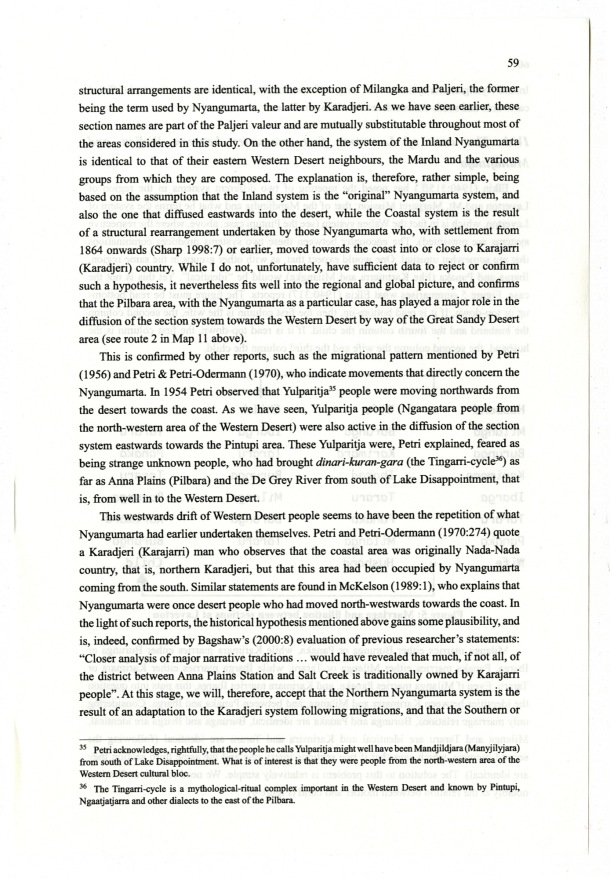|
| 
[Note: this transcription was produced by an automatic OCR engine]
59
structural arrangements are identical, with the exception of Milangka and Paljeri, the former
being the term used by Nyangumarta, the latter by Karadjeri. As we have seen earlier, these
section names are part of the Paljeri valeur and are mutually substitutable throughout most of
the areas considered in this study. On the other hand, the system of the Inland Nyangumarta
is identical to that of their eastern Western Desert neighbours, the Mardu and the various
groups from which they are composed. The explanation is, therefore, rather simple, being
based on the assumption that the Inland system is the “original” Nyangumarta system, and
also the one that diffused eastwards into the desert, while the Coastal system is the result
of a structural rearrangement undertaken by those Nyangumarta who, with settlement from
1864 onwards Sharp 199817 or earlier, moved towards the coast into or close to Karajarri
Karadjeri country. While I do not, unfortunately, have sulficient data to reject or confirm
such a hypothesis, it nevertheless fits well into the regional and global picture, and confirms
that the Pilbara area, with the Nyangumarta as a particular case, has played a major role in the
diffusion of the section system towards the Western Desert by way of the Great Sandy Desert
area see route 2 in Map 11 above.
This is confrnned by other reports, such as the migrational pattern mentioned by Petr-i
1956 and Petri Petri-Odermann I970, who indicate movements that directly concern the
Nyangumarta. In 1954 Pet:ri observed that Yulparitja” people were moving northwards fiom
the desert towards the coast. As we have seen, Yulparitja people N gangatara people fiom
the north—western area of the Western Desert were also active in the ditfusion of the section
system eastwards towards the Pintupi area. These Yulparitja were, Petri explained, feared as
being strange unknown people, who had brought dinari-kuran-gara the Tingarri-cycle" as
far as Anna Plains Pilbara and the De Grey River from south of Lake Disappointment, that
is, fi-om well in to the Western Desert.
This westwards drifi of Western Desert people seems to have been the repetition of what
Nyangumarta had earlier undertaken themselves. Petri and Petri-Odermann l970:274 quote
a Karadjeri Karajarri man who observes that the coastal area was originally Nada-Nada
country, that is, northern Karadjeri, but that this area had been occupied by Nyangurnarta
coming from the south. Similar statements are found in McKelson 198921, who explains that
Nyangumarta were once desert people who had moved north-westwards towards the coast. In
the light of such reports, the historical hypothesis mentioned above gains some plausibility, and
is, indeed, confirmed by Bagshaw’s 200028 evaluation of previous researcher’s statements:
“Closer analysis of major nanative traditions would have revealed that much, if not all, of
the district between Anna Plains Station and Salt Creek is traditionally owned by Karajarri
people”. At this stage, we will, therefore, accept that the Northern Nyangumarta system is the
result of an adaptation to the Karadjeri system following migrations, and that the Southern or
35 Petri acknowledges, rightfully, mat the people he calls Yulparitja might well have been Mandjildjara Manyjilyjara
from south of Lake Disappoinunent What is of interest is that they were people from the north—western area of the
Western Desert cultural bloc.
3‘ The Ttngani-cycle is a mythological-ritual complex important in the Western Desert and known by Pintupi,
Ngaatjatjarra and other dialects to the east of the Pilbara.
|